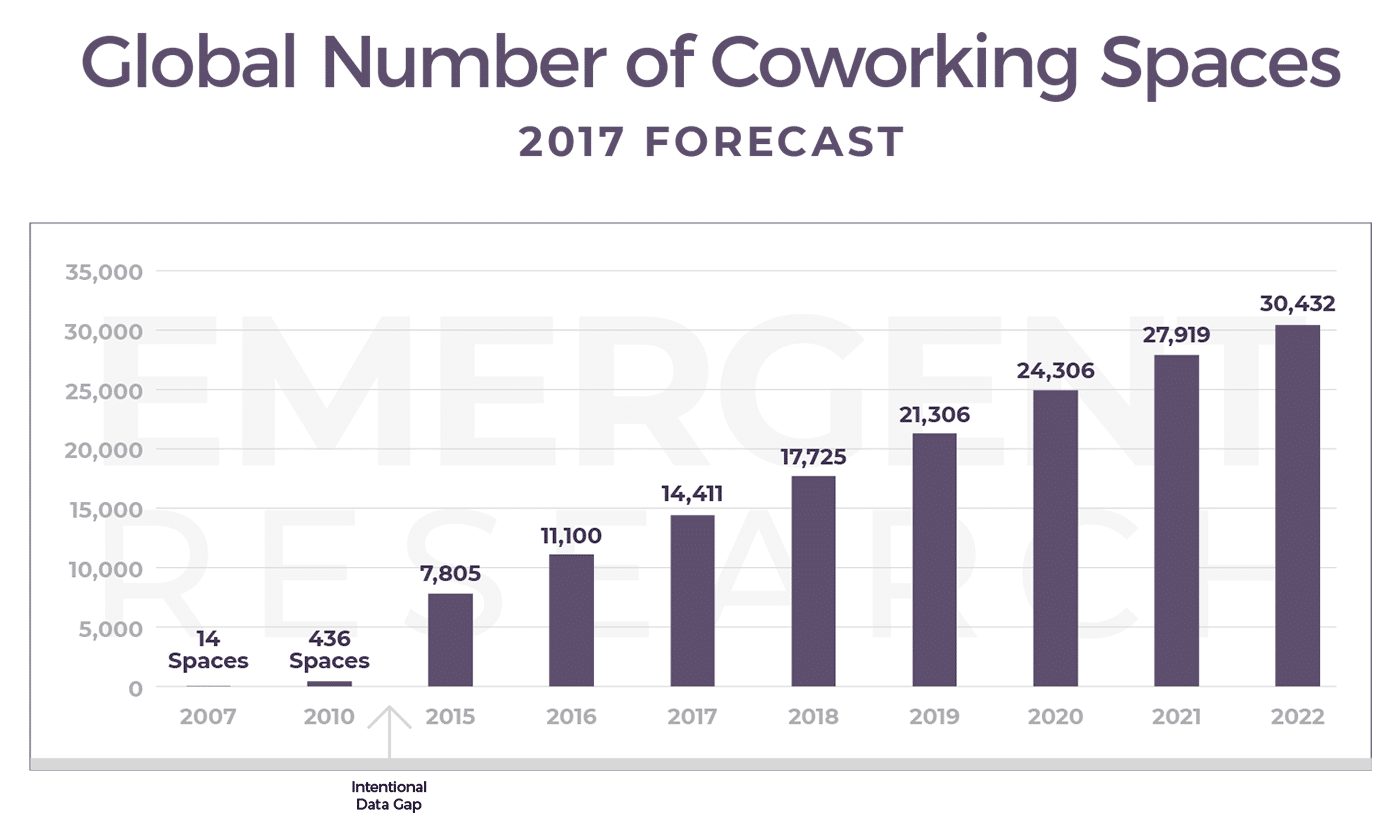If you used the term “coworking space” in a conversation 10 years ago, people would have been puzzled as to what it actually is. Fast-forward to today, and even in Colombia, the country I’ve been in for the past 6 months, there are more than 10 coworking spaces within walking distance from my place. Outside the expat community, not many people are aware that it is actually a great place to work from. The high number of coworking spaces in an unexpected country like that goes to prove the power of coworking trends within the past few years.
Raise startup capital with Crunchbase Pro – start your free trial.
And when I was living in India last year, WeWork went from three locations to 14 in the short span of fewer than eight months. And it’s not only WeWork, but there were also at least another 30 coworking spaces in Bangalore alone.
How Coworking changed society globally
I’ve been using coworking spaces for seven years now, both for my own personal projects and for working remotely for other startups. I’ve worked both part-time and full-time from hot desks and dedicated desks around the world, from Toronto to Cambodia.
What I’ve observed from the experience and by closely following the trends is that coworking spaces, in part, enabled:
- mass adoption of digital nomadism;
- the rise of social entrepreneurship;
- massive cost savings for small businesses;
- fully-remote teams (without the loneliness);
- and much much more.
Sadly, explaining how it has enabled all these changes is beyond the scope of this article.
Let’s now explore some of the current trends in the coworking space.
Trend #1: Growth of coworking spaces over the last 10 years
Let’s just start with a story of epic proportions:
- WeWork is adding 500,000 to 1,000,000 square foot of new space every month.
- They also own the largest amount of office square footage in the whole of New York City.
- Lastly, they have over 200,000 members in 295 locations worldwide.
The company is barely nine years old!
Outside their growth, coworker.com now lists over 10,000 coworking spaces around the world. Five years ago, good luck finding one Kyrgyzstan!
In the United States alone, there are about 5,000 coworking spaces. Experts forecast that there will be more than 6,200 within the next 4 years.
In 2009, there were very close to zero coworking spaces.
Trend #2: Rise of “virtual” coworking spaces over the last 2–3 years
What happens when there are no coworking spaces near you but you want to take advantage of some of their benefits?
That was my problem about 2 years ago when all coworking spaces were full in Malaga, Spain, the city I was living in at the time. Desperate, I figured maybe someone invented a virtual version of it, and if not, I’d do it myself!

Photo source: Extended: How to create an effective virtual coworking space with Jenny Lachs (The Offbeat Life)
The Google Search Term “Virtual Coworking” certainly didn’t yield many results. Back then, the only relevant result I had found was complice.co’s virtual rooms.
If you do a search for “Virtual Coworking” nowadays, you’ll come across Forest Coworking, MyWorkHive, Sococo, The Arena, FocusMate, and more.
Just earlier this year, FocusMate managed to raise over $120,000 from private investments alone. People are starting to notice the trend and the early players in the field will open the way to an even bigger “workplace” revolution.
Marc Kirshbaum, CEO of Sococo, the virtual office for remote and distributed teams, told me that during a significant renovation of their office, Summit CPA transitioned to Sococo while waiting for the renovations to complete. It turns out, they never came back to their office, preferring to stay within the virtual world!
Related: Does Your Startup Actually Need Office Space?
Coworking trends 2–5 years from now
By 2020, 50% of the US workforce will be distributed, meaning they won’t be working from a central office anymore. If we can believe that will be true next year, it’s not utopian to believe that the trend will continue in the near future.
While currently, people favor physical coworking over virtual, within the next 5 five years, I wouldn’t be surprised if virtual coworking becomes at least as popular as its physical counterpart. It’s cheaper, reduces commute time, reduces tap-on-the-shoulder interruptions, makes for a better work-life balance, etc.
Physical coworking spaces certainly won’t be out of the picture. They are indeed projected to keep growing. The rise of clients for both virtual and non-virtual will come from firms who previously had a traditional office and no longer see the benefits outweigh the hindrance.
Physical coworking also offers one thing that’s hard, if not impossible, for virtual coworking to replicate, and that’s physical contact. Biologically and psychologically, having physical contact with other people is a good way to keep sane. As much as video chat helps, it simply can’t replace that.
When talking about the subject with Kirshbaum, he agrees that this is currently impossible. However, the future is bright for Virtual Reality to help that become a reality. The technology already exists to project yourself and others in a virtual world. With extra advances in technology, we could also simulate physical contact and other senses.
While this is unlikely to happen with the next five years, there will certainly be research done and those who take advantage of it will be the forerunners of an important “workspace” revolution.
4 ways startup founders can take advantage of the new trends to maximize their team’s performance
Given the growth of both virtual and non-virtual coworking spaces, startup founders who take advantage of both trends will be better positioned to maximize their team’s performance.
1. Switch from no office to a virtual office
Many companies now have fully or partially remote teams. They use tools like Slack and/or Zoom for communication. You acn also use Trello, Asana or Airtable for project management, and Google Drive or Dropbox for document storage.
One thing most are currently missing is a virtual office; a central “location” where everyone on the team regroups and keeps each other accountable. Some would argue that Slack is doing that but the reality is that companies like Sococo are currently better positioned to fill that gap. Working in a virtual office empowers remote teammates to feel present in their online space and to work as if they were in the same room as their colleagues.
It’s a great way for founders to show their team that they are indeed part of a team, considerably boosting employee morale.
2. Use physical coworking spaces
I’ve been using them for seven years with reason. Being surrounded by other hard-working people is really motivating. You get to expand your personal and professional network, you have access to events and activities, you get the physical contact you can’t get with virtual coworking, etc.
Plus, they are relatively cheap, have great wifi, and most offer good coffee or tea for free.
Startup founders can take advantage of this trend to keep employee satisfaction up but also to open up opportunities to meet new future employees or clients for their business.
Most of the people I work with or do business with today are people I met at a coworking space.
3. Reduce interruptions
The biggest source of distraction from offices comes from tap-on-the-shoulder interruptions. Since most jobs nowadays require employees to be focused on their task more regularly than to be collaborating, keeping that focus is of utmost importance for an employee.
Both physical and virtual coworking offers a solution to that. By not being surrounded by people from your own company, physical coworking spaces are a good solution. Most of such interruptions happen when a colleague “need” your help on their own problems. If the person next to you isn’t a colleague, there’s less chance they’ll interrupt you like that.
In virtual coworking, it’s physically impossible to tap someone on the shoulder, making it much easier to ignore.
Reducing such interruptions can lead to considerable productivity gains.
4. Increase work-life balance
In both scenarios, work-life balance has the potential to be a lot better. It’s possible to work with people you care about, even if they don’t work on the same projects.
I work with my wife from coworking spaces frequently. We get to have lunch together, chat about our things, and when comes time to do things together after work, we don’t have to chat about our day-things because we know what each has done, giving more time for meaningful activities.
The most important aspect of increased work-life balance is employee satisfaction. A happy employee performs much more than an unhappy one.
By adopting the new trends in both physical and virtual coworking, startup founders can greatly increase the productivity of their team.
By feeling they’re part of something, by being surrounded by diverse groups of people, by reducing interruptions, and by increasing their work-life balance, employees can’t help but be happier at work and perform at their best. Not because you told them what to do but because they see that you care about them and they care about their work in return.
Will you adopt these trends? Are you already adopting them?
Danny is a Top Writer on Medium.com, writing about Inspiration, Self Improvement, Productivity, Education, Entrepreneurship, Life, Life Lessons, Startup, Photography, Gaming, Travel, and more. Outside of writing, Danny is a Serial Entrepreneur, Software Engineer, Photographer, Constant Learner, Learning and Productivity Coach, Public Speaker, and Husband.






